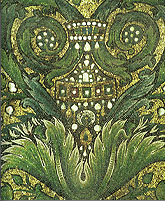|

Early Islamic Art in Jerusalem
|
The city of Jerusalem was taken by the Muslims a mere four years after Islam had begun to spread outside the Arabian Peninsula (638 CE). It therefore preserves some of the earliest traditions of Islamic art. Not much is known of the early stages of Islamic architecture, save the testimony of Arculf, a pilgrim who visited Palestine between 679 and 688 CE. Arculf described a structure that should probably be identified as the ancient Al-Aqsa Mosque erected on the Temple Mount by `Umar. The Mosque was constructed along the southern wall of the Temple Mount, occupying the site of the Herodian Royal Stoa and reusing its building materials. |
|
The true efflorescence of Islamic art and architecture occurred in the days of the Umayyad dynasty, after 685 CE. The Umayyads were influenced both by the rich religious and artistic traditions of their Christian and Jewish predecessors, as manifested in the ruins of the Temple Mount and the Byzantine churches. In contrast to the Umayyads, the Abbasid dynasty's contribution to the building of the city was very minute, and not much has survived from the little that was accomplished in their days. Neither was there grand construction in Jerusalem under the Fatimids, but they are credited with the repair of existing structures, chiefly the Mosque of `Umar. The Fatimid construction outside Jerusalem is, however, one of the high points of Islamic art. |

|


